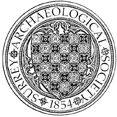Lime House, Church Street, Cobham
Excavation by A Hall of SyAS to investigate whether the early 18th century Lime House was built at the rear of an older house. Excavation revealed pottery of 13th/14th and 17th–18th century date, two 18th century clay pipes, and 19th–20th century building rubble, but no finds or features to indicate the existence of an earlier building. (379)


